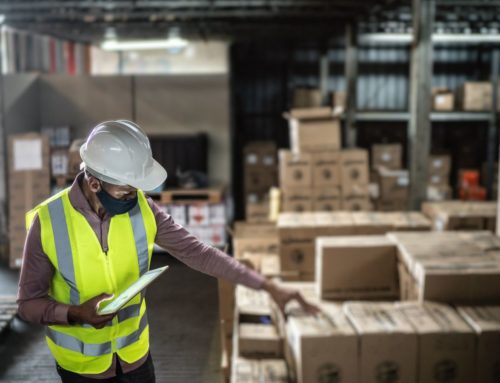Wonolo
Once in awhile, a game changer emerges to transform everything we ever knew. It’s no secret that Amazon is such a company in more ways than one. But when it comes to their warehousing practices, exactly how has it changed the landscape for others in the industry?
Such a vast operation inevitably has a wider effect on the warehousing and storage industry as a whole, particularly in the areas of real estate and the workforce. Add Amazon’s investment in advanced technology into the equation, and the changes become even greater.
Here are the three ways in which Amazon has made the biggest impact, as well as what competitors could do to remain in the game.
More demand for industrial real estate
As of 2017, Amazon is on course to continue its expansion of nationwide fulfillment centers as it announces a stream of new openings in states including Florida, California, Georgia and Illinois.
Though the company isn’t completely transparent about its operations, MWPVL International, a supply chain consulting firm, puts the current estimate for Amazon’s facilities at around 214 centers within the U.S.

Source: Business Insider
While this seems like a lot, it’s still not enough. According to STAG Industrial CEO Ben Butcher, “the requirement for warehousing space will increase substantially” to accommodate e-commerce demands, even as existing retail space in the U.S. faces an alarming rate of closure.
In what’s being termed a “retail apocalypse,” more than 5,300 stores were expected to close as of June 2017, making it more than likely to put the total number of store closures this year to surpass that of the worst year for store closures on record – which was 2008, the year of the economic crisis.
Certainly, e-commerce giants like Amazon have helped to decrease sales for these stores, but a more interesting statistic may be that the U.S. simply had too much retail space to begin with, at 23.5 square feet per person, placing it far above Canada and Australia. However, the decrease in retail space has opened up even more opportunities for warehouses and investors.
“Amazon is an outlier in terms of the advanced stage of their supply chain buildout – others will need to catch up, which will be a continued tailwind to industrial demand.” – Ben Butcher, CEO of STAG Industrial
In New York and New Jersey, the industrial real estate market has seen a boom in recent years, while commercial sales in the borough of Brooklyn dropped by 77% in a year. Kyle Schmidt, from the real estate company Cushman & Wakefield, says 51% of the 9.4 million square feet of industrial space under construction has already been pre-leased.
Much of this bustling activity is a result of Amazon’s actions, as well as the changing consumer behavior in favor of e-commerce. According to Karl Siebrecht, CEO of Flexe, “Amazon came in and turned supply chains into a growth weapon. Now the whole retail industry is trying to keep up.”
Though the rise of e-commerce and decline of retail in the context of surplus space seem inevitable, Amazon has sped up the shift, leading to a highly increased demand in industrial real estate.
Changes in the workforce, for better or for worse
With more warehouses comes more jobs. For areas where job growth has been slow, it’s a welcome breath of fresh air to see a large number of new jobs at once – 1,000 warehouse jobs in Sacramento’s case.
Earlier this year, Amazon announced its plans to bring 100,000 jobs to the U.S. within 18 months. Across the ocean in the UK, it is set to create 1,200 warehouse jobs for its new facility in Warrington, as well as 1,650 jobs for its “receive centre” in Coventry, where workers will sort products ordered through the UK site.
In fact, the company’s rate of hire now far outpaces that of others like Microsoft and Google, with a total of 341,400 employees as of 2017. That makes it the largest internet company in the world.

Source: GeekWire
However, the company has also faced criticism for its intense management practices, and some studies found that the wage at an Amazon warehouse was lower than the average in some areas.

Source: ILSR.org
The other prospect is that while creating more warehouse jobs, Amazon has also helped to take away other jobs in retail. As with any other technological revolution, it remains unclear whether its effects on the workforce are more positive or more negative in the long-run. What’s more, Amazon’s heavy investment in robotics will probably have a much larger impact on the workforce than is evident at the moment.
The robot arms race
Not content with its role in the changing face of retail, Amazon continues to innovate and change the industry through its robotics technology, primarily in two areas:
- Drone delivery robots
- Robotics-equipped warehouses
Amazon Prime Air, a service that launched in 2016, utilizes drones to deliver packages to customers; testing is currently underway internationally as well. The company’s use of this technology will expand, especially if its latest patent goes through, which would allow the drones to scan customers’ homes for information they could then use to advertise more relevant products for the residents.
But perhaps the biggest change lies with warehouse robots that can easily perform the same tasks warehouse workers can, with greater efficiency. In California, warehouse recruitment showed signs of slowing in the past few years, which correlates to its new robot-equipped warehouses. Tasks that used to take several hours and ten workers now only require an hour at most, and three workers.

Source: LA Times
In particular, Amazon’s investment in Kiva robots drove out its competitors, who could no longer rely on the technology. A study by Deutsche Bank revealed that the use of Kiva robots could save a company $22 million. So while Amazon had a monopoly on this market, its competitors had to look elsewhere for effective strategies, such as better employee management to boost productivity.
It turns out that while the U.S. invests in robots to increase output, it isn’t exactly making the most use of its human workforce. In a study by Expert Market, the country ranked low in output compared to other countries with less working hours, while countries like Costa Rica and Mexico were at the bottom of the list, despite the fact that they put in the most hours at work.
For companies that don’t have Amazon’s resources for robotics investment, paying attention to the human employees and working to create better conditions can seriously increase the dollar value of each productive employee’s hourly output.
How to stay in the competition
Amazon’s revenues and funds are hard to compete against, but new players are arriving on the scene to tackle its near-monopoly. Companies like Flexe, a marketplace for warehouses, directly challenge Amazon by striking a deal with 550 warehouses, allowing them to provide better coverage across the country.
Better working conditions can also attract workers who find Amazon’s policies stressful and unstable. The robotics industry will grow to accommodate multiple players, allowing competitors to invest in other equipment than those Amazon has a monopoly over. Increasing interest in industrial real estate will create more opportunities for investors who are setting their eyes on Amazon’s competitors.
There’s no doubt Amazon brought about significant change in the industry. But as with all historic change, the first player doesn’t always come out on top. Others can catch up while learning from Amazon’s mistakes and building on its successes to form even better strategies.





